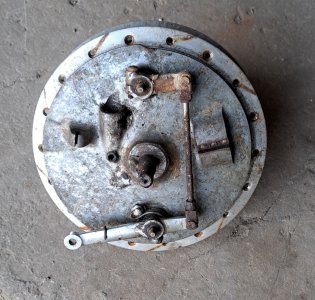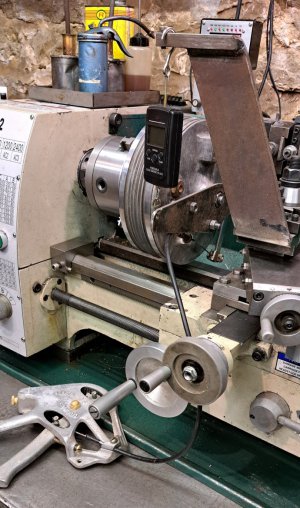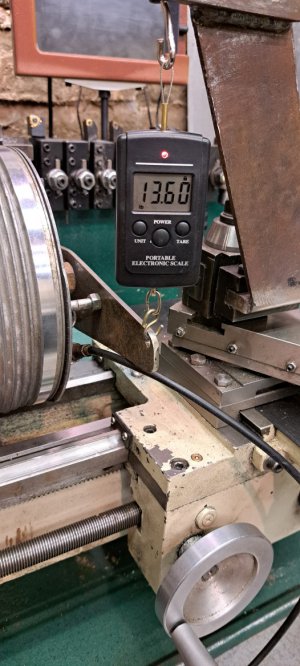- Joined
- Feb 1, 2015
- Messages
- 9,605
In order to assess the performance of the new motor, I needed a way to measure torque. A 200 year old device called a Peony brake offered a way. A Prony brake consists of a drum or wheel attached to the rotating shaft and a means of applying friction to create a load. Originally, this was accomplished by using a wooden block as a brake shoe. As force is applied, the shoe would rotate due to the drag created and the force restraining the rotation is a measure of the torque created by the load. If a lever of known length is used to apply the force and the force is applied perpendicular to the line through the axis of rotation. the torque is the product of the lever length measured force.
I happened to have a brake assembly from the front wheel of an old motorcycle of unknown make which seemed to fit my needs. I turned the flanges for the spokes off the as they wouldn't be needed and mounted a 6" lever arm on the fixed plate using three 3/8" studs. I also shortened the axle on the fixed plate side. I had the brake cable but was lacking the hand lever assembly. I happened to have a remote cable control from a hydroplane that I bought that work well though. To measure the force, I bought a cheap digital baggage scale the measures to 50 lbs. to hold the scale, I welded up a bracket that fit one of my QCTP holders. This made positioning correctly a simple task.
I have yet to do a thorough series of tests on my lathe but there are a few preliminary results of interest.
First and foremost, the Grizzly G0602 is torque limited by the drive belt to around 10 - 12 lb-ft of torque. This is not surprising since the drive belts used are 3L belts. Since the belt is slipping, the mechanical advantage normally expected from changing the pulley ratio isn't realized.
Second, the lathe was still delivering 10 lb-ft. of torque at 10 rpm or 1% of maximum rpm on the medium-low pulley configuration. At 4 rpm, the motor would pulse under load as the feedback encoder frequency was low enough that the drive inertia could no longer smooth out the drive. On the low-low pulley configuration, at 4 rpm the drive belt would slip at a 12 lb-ft. load but the lathe was running smoothly.
The third point of interest was the decrease in rpm with increasing load. At the point of slipping, the rpm drops about 20% although some of this is due to belt slippage. This is somewhat disappointing but there is still some tuning to perform which may improve performance.
The Prony brake has proven a useful tool in providing objective data as to performance of the lathe. As I complete the evaluation of the G0602 motor swap, I will be publishing the build details in a future thread.
The photos show an unmodified brake assembly and two views of the mounted Prony brake, the second photo showing the hand control below the lathe bed.



I happened to have a brake assembly from the front wheel of an old motorcycle of unknown make which seemed to fit my needs. I turned the flanges for the spokes off the as they wouldn't be needed and mounted a 6" lever arm on the fixed plate using three 3/8" studs. I also shortened the axle on the fixed plate side. I had the brake cable but was lacking the hand lever assembly. I happened to have a remote cable control from a hydroplane that I bought that work well though. To measure the force, I bought a cheap digital baggage scale the measures to 50 lbs. to hold the scale, I welded up a bracket that fit one of my QCTP holders. This made positioning correctly a simple task.
I have yet to do a thorough series of tests on my lathe but there are a few preliminary results of interest.
First and foremost, the Grizzly G0602 is torque limited by the drive belt to around 10 - 12 lb-ft of torque. This is not surprising since the drive belts used are 3L belts. Since the belt is slipping, the mechanical advantage normally expected from changing the pulley ratio isn't realized.
Second, the lathe was still delivering 10 lb-ft. of torque at 10 rpm or 1% of maximum rpm on the medium-low pulley configuration. At 4 rpm, the motor would pulse under load as the feedback encoder frequency was low enough that the drive inertia could no longer smooth out the drive. On the low-low pulley configuration, at 4 rpm the drive belt would slip at a 12 lb-ft. load but the lathe was running smoothly.
The third point of interest was the decrease in rpm with increasing load. At the point of slipping, the rpm drops about 20% although some of this is due to belt slippage. This is somewhat disappointing but there is still some tuning to perform which may improve performance.
The Prony brake has proven a useful tool in providing objective data as to performance of the lathe. As I complete the evaluation of the G0602 motor swap, I will be publishing the build details in a future thread.
The photos show an unmodified brake assembly and two views of the mounted Prony brake, the second photo showing the hand control below the lathe bed.




